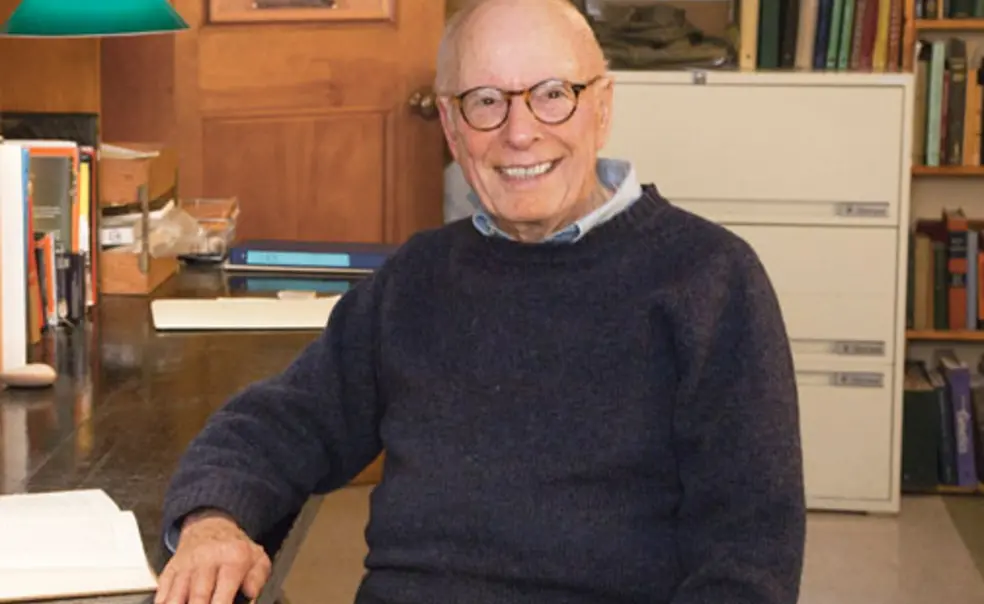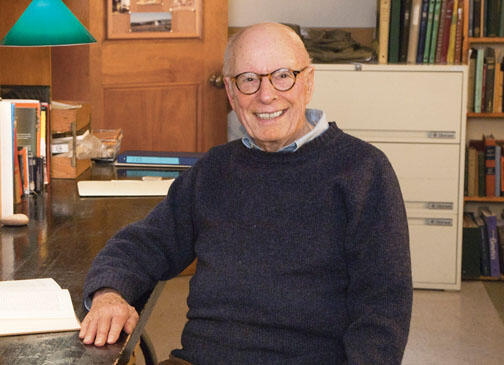IDEAS: When Darwin isnt the answer
Life on Earth varies enormously in size, from single-celled microorganisms to giant sequoias weighing 2 million pounds. Does evolution work the same way for the smallest life forms as it does for the largest? Biologists long have argued that it does. But a new book by John Tyler Bonner, Randomness in Evolution (Princeton University Press), makes a new claim: that tiny organisms often are shaped by completely random forces instead of by Darwinian natural selection.
Bonner, the George M. Moffett Professor of Biology emeritus, came to his conclusion by long experience studying the minute and strange organisms called slime molds, starting in his student days and continuing in his Guyot Hall lab until two years ago.
All organisms are subject to random mutations; evolution then selects for those mutations that are beneficial. But Bonner argues that randomness plays a powerful role in small organisms, including slime molds, because it instantly can produce viable results, so simple is the development of these organisms as they grow.
By contrast, bigger life forms undergo long, complex cellular development in the embryo, in which random mutations tend to wreak havoc by introducing fatal abnormalities. “Large size gives you a fantastic number of hurdles” that natural selection must overcome before producing a permanent effect on the species, Bonner says. Only the very rare mutations will yield viable results.
It is largely random alterations, he argues, that account for the extraordinary diversity of small creatures. “There are 100,000 species of diatoms” — a type of one-celled algae — and not 100,000 species of elephants, he notes. That got him thinking that evolution may work differently based on size, he says.
Evolutionary biologists typically would argue that there are 100,000 types of diatoms because there is some competitive advantage to each of those types. But Bonner believes that “sometimes, every one of the mutations is equally successful in the struggle for existence,” producing variety that owes nothing to Darwinian evolution. By contrast, he notes, his mainstream peers “say that never happens: There is always competition.”
“Some will read it and think, ‘Why didn’t I think of this?’” Bonner predicts of his book. “Others will say, ‘He’s a radical.’ Because this really goes against the grain for most evolutionary biologists, who think selection works exactly the same way for small and large.” Even good friends “are furious with me,” he says.
Emeritus professor of zoology Peter Grant says that by challenging evolutionary biologists to justify invoking natural selection to account for the diversity of form among microorganisms, Bonner’s book is “controversial, but valuable at the same time.”













1 Response
Charles W. McCutchen ’50
9 Years AgoEvolution's predecessors
History red in tooth and claw, or the evolution of evolution. Before Professor emeritus John Bonner (Campus Notebook, April 24) was Darwin. Before Darwin, there were at least three others.
“The theory of natural selection, or survival of the fittest, was suggested by William Charles Wells in 1813, and further elaborated by Patrick Matthew in 1831. But the pregnant suggestions of these writers remained practically unnoticed and forgotten, until the theory was independently devised and promulgated by Charles Robert Darwin and Alfred Russell Wallace in 1858, and the effect of its publication was immediate and profound” (Encyclopaedia Britannica, 11th Edition, Handy Volume Issue, Vol. 10, page 34a. 1910).
In the “Historical Sketch” in the Sixth Edition of The Origin of Species, Darwin wrote that in a paper read in 1813 and printed in 1818, “Dr. W.C. Wells … distinctly recognizes the principle of natural selection … but he applies it only to the races of man, and to certain characters alone.” Further, Darwin wrote, Patrick Matthew in 1831 had given “precisely the same view on the origin of species” as that of Mr. Wallace and himself.
Earlier, the geologist James Hutton (1726-1797) wrote that natural selection explained the development of varieties – but not of species, which were ordained by God (see Paul N. Pearson, Nature, Vol. 425, page 665. 2003).
Being first did not fit Hutton, Wells, and Matthew to survive predation by establishment censors.